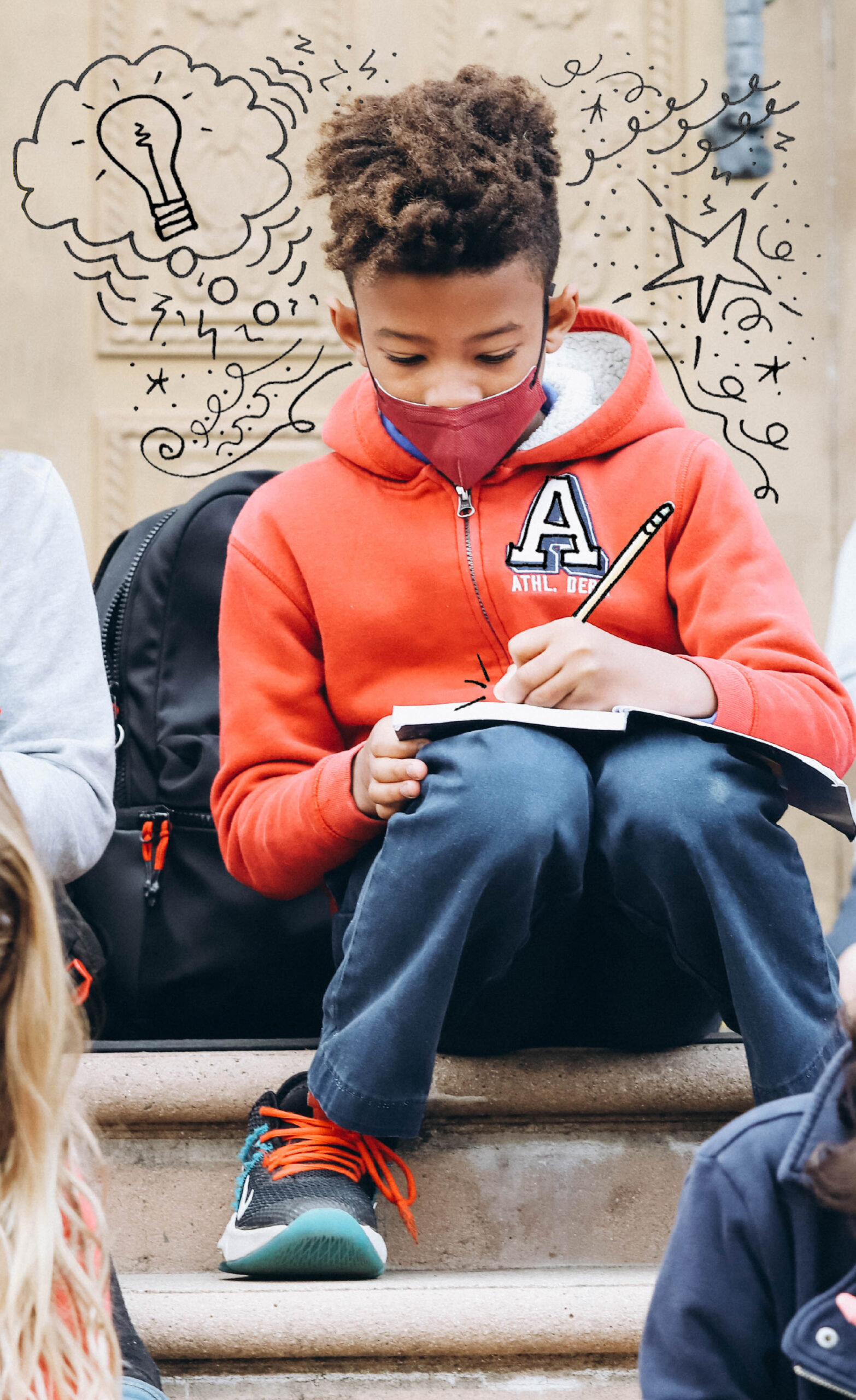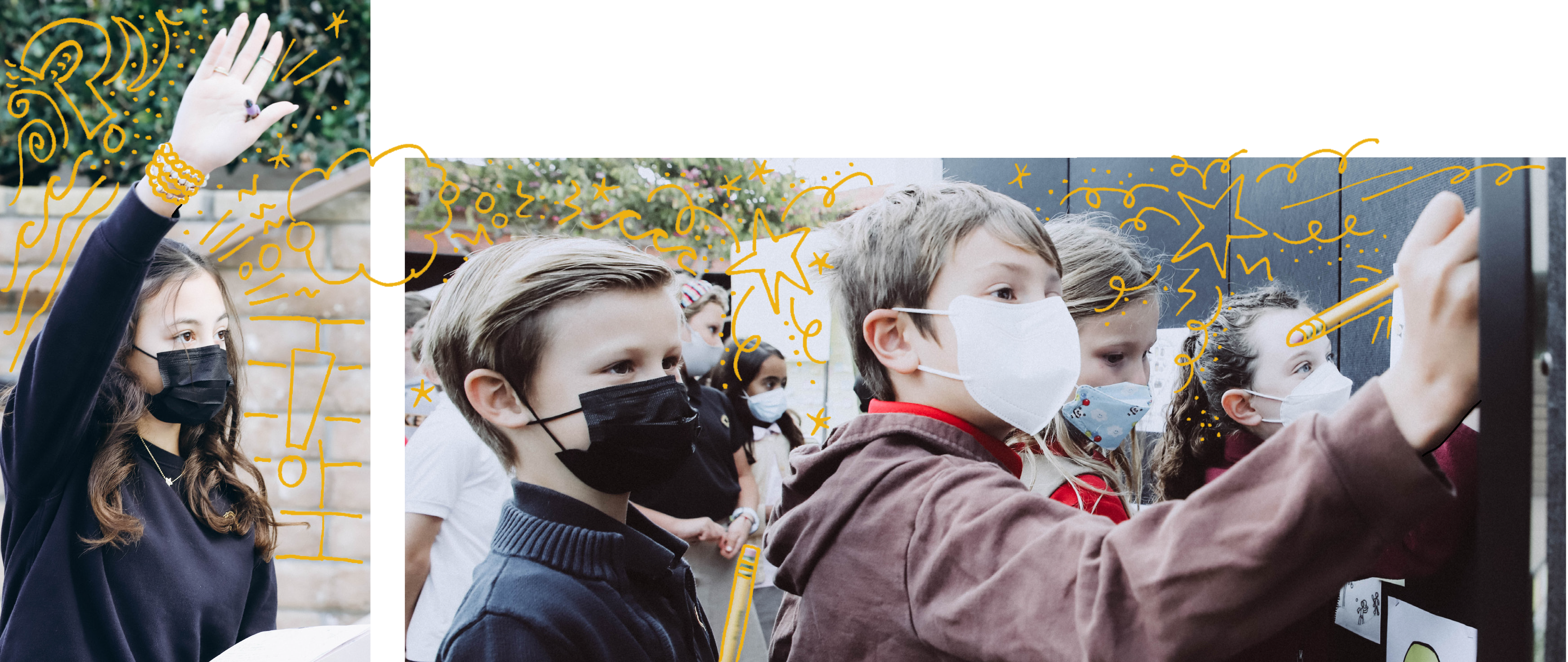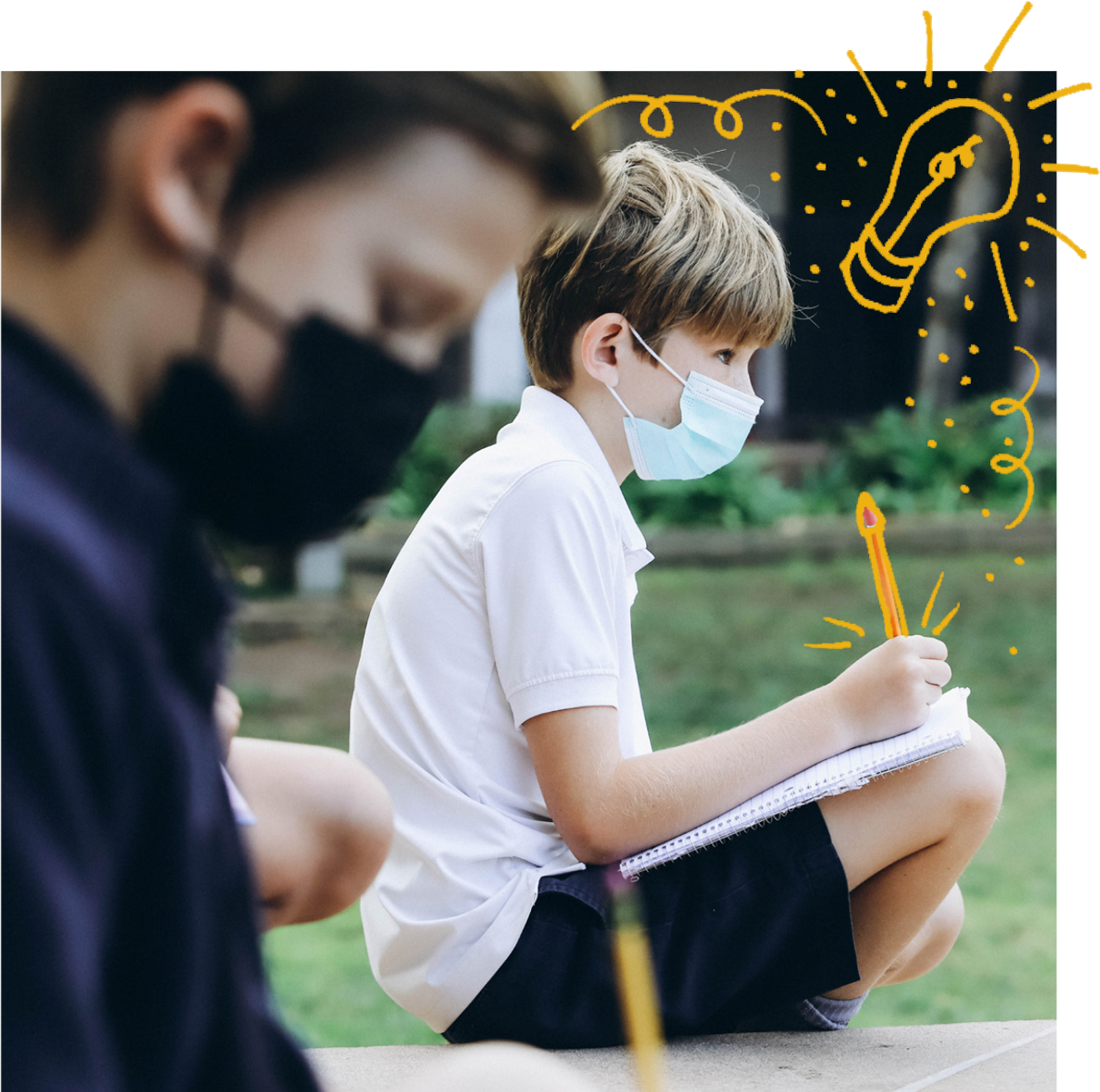
Lower School Student Council seeks to create positive change
By Matthew Piechalak
This story originally appeared in the spring 2022 issue of Parker Magazine.
“Do any little people need a big buddy?” advisor Karishma Sinnott calls out to members of the Lower School Student Council as they gather on the steps of the Szekely Auditorium. Several tiny hands shoot up into the air. Older members of the council—in Grades 3 to 5—seek out those asking for help and sit beside them.
All students present are equipped with a notepad and a writing utensil, eager to be an invaluable part of this democratic process of student government. It’s their job to create positive change for their peers, their school, their community, and themselves—a role each student takes very seriously.
“You have leadership on your shoulders,” says Poppy Namazy, Grade 5, who currently serves as the council’s co-president along with fellow Grade 5 student Sophia Del Gaizo. “You get to know other students and it feels like you’re really important because everyone looks up to you,” continues Poppy.

Growing Young Leaders
“The goals of the student council are to keep the traditions of the Lower School alive, to make sure every student has a voice, and to serve the community,” says Karishma. “My first job is to listen to them—to hear what they need and want.”
The council is composed of 30 students—two representatives from each class from Grade 1 through Grade 5. The council is elected each trimester, meaning that in one school year, 90 students—roughly a third of the student body at the School’s Mission Hills Campus—are active members.
“We encourage students to share their voice and teach them to provide thoughtful solutions when something isn’t going well,” says Heather Gray, the Dr. Robert Gillingham Head of Lower School. “Student council helps students see the fruits of their efforts and improve their community.”
Each Tuesday, the council meets before school in the Gillingham Family Courtyard to discuss the important business that affects all those attending Lower School.
On the agenda today is voting on T-shirt designs for Language and Culture Week. But first, they welcome a special guest—a peer interested in enlisting the council to help collect donated toys and books. As the young student quietly communicates her idea, the council members jot down copious notes. When she is done, they thank her with a round of applause and set about the work of brainstorming ideas to fulfill her request.
On a giant board, Karishma captures their ideas. Though all ideas are considered, the council understands it is their job to determine the feasibility of each, and ultimately narrow them down to those that will be presented for approval.
“If it stays on the board, it’s a ‘maybe’,” she explains. “But then I always tell them it has to be approved by Mrs. Gray.”
The young changemakers are eager to affect their world in positive ways. Common requests include breakfast and lunch menu alterations, special dress down days, recycling Expo markers, and starting a compost bin. The requests all have one thing in common: they are grounded in an understanding of the democratic process.
“Their asks aren’t extravagant at all,” Karishma says. “They don’t come and ask for a zillion dress down days. Everything they ask for is fair—and they only ask that which the whole class wants.”

One For All
At each meeting, the Grade 1 and 2 representatives speak first. Along with the buddy system of note taking, it’s a way to ensure that all voices are heard equally. According to Karishma, it’s also a way to help grow agency in the youngest members.
“It’s nice because the little kids don’t feel like they are struggling,” she says.
At the conclusion of every meeting, members in Grades 4 and 5 visit the Junior Kindergarten and Senior Kindergarten classes to report on their agenda and to field questions and concerns from the youngest students on campus. Quite literally, every Lower School student is a part of the ongoing process for change.
“It’s a very big leadership opportunity,” say Amani Solorio and Laird Anderson, both Grade 5 students who served as first trimester co-presidents. “Our job was to report to classrooms to tell them what was going on in the School, but also to share our ideas and hear theirs,” says Amani. “You feel that you are in charge of everyone having a voice,” adds Laird.
“We want JK and SK to be heard,” Karishma says. “Whatever they desire, the members bring it back to me.”
It doesn’t always yield results—one JK class who felt their classroom was too big was not able to move to a smaller room—but the kids learn and come to understand that their voice matters. Additionally, it instills a sense of wonder about student council and gets the kids excited to run for it when they reach Grade 1.
“The whole School looks up to you, especially the younger grades, as someone they want to be like,” says Laird.
Fair and Equitable
This year, the council changed the way they hold elections to make it a much more equitable process. Previously, it was a traditional election where the top two vote getters would be elected. This left many students who weren’t chosen too disheartened to run again.
“Last year, I had emails from children telling me that they had tried so many times to get on student council and they were never elected,” Karishma explains. “Everyone who runs deserves to be on the student council.”
Lower School Culturally Responsive Reading Specialist Rebecca Bellingham recommended a Malcolm Gladwell podcast on student elections. It inspired a change in approach: there would still be a traditional vote where each candidate had the opportunity to give a speech and the top vote-getter would be elected, but from there, every other candidate would get their name put into a hat, and an additional candidate from every class would be elected by a random draw.
“We don’t tell them which was picked by popular demand and which was picked out of a hat,” Karishma says, adding that it has created more interest and more confidence among the student body. “It’s been the best change we’ve made to the council, ever. It’s a new Parker tradition.” She recalls one student in particular, a shy girl who was initially reluctant to run, who was “transformed” when she was elected. “She came up here and her confidence bloomed.”
Sophia can relate. She explains how scary public speaking seemed to her prior to being elected co-president, a role in which she must not only talk during council meetings, but also during weekly Flag Raising events. “I learned it’s better to mess up and try in front of people that we know than to never do it and have to do it one day in front of strangers,” Sophia says.
“When you learn something new and then it comes up again in your life, you will already know how to do it and it will feel natural,” adds Poppy.
The election changes have been inspiring, says Heather. “We want to tell our students that their voice matters; that any one of them is worthy of being on the council. It is our hope that we are shifting toward a system that honors the hard work and determination of our young friends, while recognizing that democracy hasn’t lost its place at Parker.”

Advocates for Change
Each school year, the council strives to execute at least one service project, one community project, and a variety of smaller projects intent on creating positive change. This year, they have been able to get approval for one carb snack at lunch per week, the installation of two new water fountains, and have created “thank you” posters for faculty, staff, and parents.
But it is their donation drives, which have extended into partnerships with other divisions and departments at Parker, that are truly inspiring. Last fall, the council was instrumental in organizing a drive to support Afghan refugee families arriving in Southern California. Together with students from across divisions and Director of Community Engagement Kevin Dunn, the students arranged the collection of clothing, toys, household supplies, decor, and furniture to furnish apartments for families recently airlifted to safety. Moving forward, the council plans to work with Kevin on one school-wide service learning project per trimester.
It’s precisely this kind of change that has the council moving enthusiastically forward while growing young leaders. “It has been inspiring to watch the agency students develop when they join the student council,” Karishma says. “They have a lot of power, and their little ideas grow very big wings.”




